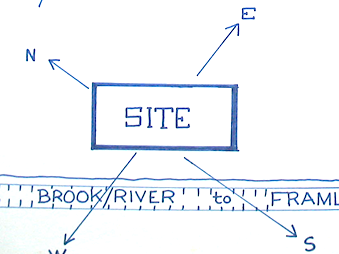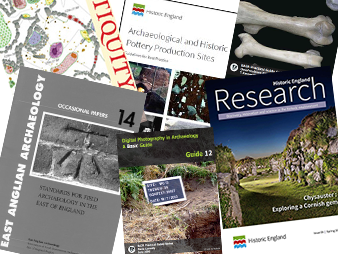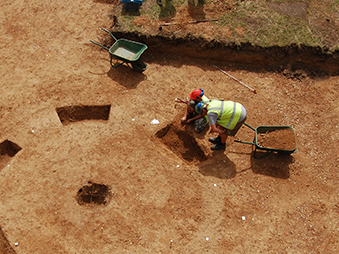Excavation by its nature destroys the archaeology and so it should be the final stage of investigation on any site after as much information as possible has been sought using other non-intrusive methods, such as documentary research, fieldwalking and geophysical survey. These methods will provide information to help you target your excavations, whilst answering specific questions.
Be Prepared
It is important to think carefully about all stages of excavation before you begin to make sure you have enough resources to complete and write up your work.
Have you put aside funds for not only the excavation equipment and facilities but also for the post excavation stages, including professional environmental and finds specialists? Are you likely to need to use expensive scientific techniques such as radiocarbon dating?
Do you have landowner permission? You must obtain permission from the landowner and tenant (both should be consulted) before starting any fieldwork. Also check the land is not a scheduled Ancient Monument or under Natural England stewardship, if it is this will mean that extra permissions are needed to excavate.
Where will the excavation archive go? You need to discuss with the landowner whether they wish to retain ownership of any finds or if they would be happy for the whole excavation archive to be deposited with a local museum or archaeological archive. We recommend for all excavated archives to be deposited with the County Archaeological Archives, so that all material is curated for the future.
SCC Archaeological Service is the main archive repository in Suffolk, so get in touch with us at an early stage to discuss depositing your excavation archive.
Create a project design before you begin.
What to include in a project design?
Your project design should include:- Location maps and topography
- A summary of your desk-based research
- The project aims, explaining what you are trying to find out and why you are excavating. These aims may impact on how you decide to excavate.
- An excavation strategy and methodology. Are your project aims and research questions better answered by test pits, small trenches, or open area excavation? Will you dig by hand or use a machine to remove topsoil? How do you plan to excavate and record the types of archaeology you expect to encounter? What are your strategies for things like environmental sampling and finds retrieval, will you sieve all feature fills for example?
- Think about the type of archaeology you are expecting to encounter and what specialist advice you may need. Are you expecting pottery and animal bone? Do you have professional local specialists lined up to help identify this? Although we recommend you avoid human remains if they are encountered you will need a licence from the Ministry of Justice before excavating.
Download Project Design Template (PDF) »
Send your project design to SCC Archaeological Service by email to archaeology@suffolk.gov.uk. We can offer advice and issue you with a unique HER number. This number is for use on all site records and post excavation work and locates and identifies your project in the Suffolk HER.
In the Field
Health and safety
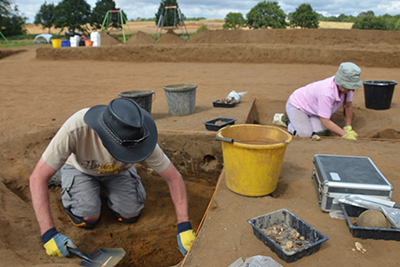
Complete a Risk Assessment for your activities, and make sure that your society has a Health and Safety Policy. Insurance companies will expect that you adequately anticipated risks and hazards and you need adequate insurance for your activities. Also make sure you have an adequate number of First Aiders on site.
Before you begin check that there are not any underground services (pipes, electricity cables etc.) by looking at Service Maps, using a CAT scanner and asking the landowner.
Make sure you have adequate welfare facilities for your participants including shelter, toilets, storage for tools, finds and car parking.
Tools
Make sure you have all the tools you need whatever your methodology.
Download an example tool list for an excavation (PDF) »
Finds and Environmental Samples
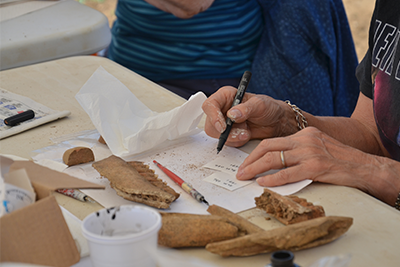
All finds need to be bagged on site with their site code (your unique HER number), and context number. Ideally write the context number on the bag and on a label inside the bag so they do not get muddled.
Small finds, which are usually the more fragile and/or metal finds, need to be individually numbered on a Finds Register and located using a GPS.
Environmental samples can be collected to be analysed and processed to recover of carbonized remains and small objects. Bulk soil samples of 40 litres are usually taken from a single fill of an archaeological feature. Monolith and other smaller samples may also be taken for the recovery of pollen. You should think about your environmental sampling strategy before starting your excavation.
SCCAS can advise on environmental sampling and where necessary, specific advice for complex remains can be sought from the Historic England Regional Advisor for Archaeological Science (East of England).
For further guidance, see Historic England – A guide to the Theory and Practice of Methods, from Sampling and Recovery to Post-Excavation (2011)
Recording the Archaeological Remains

Make sure all archaeology is fully recorded.
Most archaeological excavations are recorded using the single context recording system, whereby every cut and fill(s) of a feature, or layer, is issued a context number, which is recorded on a Context List. Context Recording sheets will need to be completed for all features.
Before you excavate your feature, draw a pre-excavation plan, it also needs context numbers. Once excavated draw a section and a post-excavation plan. Plans are normally drawn at 1:20 and sections at 1:10.
Take a photograph of every feature with a scale, north arrow and photo board with the site code (your unique HER number) and context number. All photos should be logged on a Photo Record.
Advice and templates for archaeological recording can be found on bajr.org (PDF)
Post-excavation
Finds Processing
Finds, such as pottery, animal bone, tile and worked flints need to be gently cleaned, be especially careful with fragile animal bone, which may need to be dry brushed. Also make sure to inspect any pottery closely for residues before cleaning. Once the finds are completely dry, they need to be sorted by material type and discreetly marked with the site code and context number. Metal work should not be washed or marked. Some more fragile finds may need to be sent to a conservator to be stabilised.
Environmental samples will need to be processed to recover carbonised material and small objects.
Once the finds have been processed they will need to be identified by a professional specialist, prior to writing a report of the excavation.
Finds which come under the jurisdiction of the 1996 Treasure Act need to be reported to Suffolk’s Finds Liaison Officer. You have a legal responsibility to report them within 14 days of discovery. Find out more about Treasure.
Report
Reports should contain a Summary, Introduction, Aims, Methodology, Results (including finds summary), Discussion and Conclusions, Recommendations for further work, References and location maps. Specialist finds reports, full descriptions of every context, section drawings and plans should be appended to the report.
Send a digital copy of the Report to SCC Archaeological Service by email to archaeology@suffolk.gov.uk, so it can be included in the HER record.
Also upload a copy to OASIS, an online reporting tool for the Archaeological Data Service.
Archiving
Once you have completed the report, the excavation records can be deposit to the relevant archaeological archive. This includes, artefacts, written excavation and post-excavation records, drawings and maps, photographs and slides and digital records. A Transfer of Ownership form, copyright statements and photography permission forms (as appropriate) will be required.
SCC Archaeological Service is the main repository for archaeological material recovered by all commercial and community lead excavations in Suffolk. Contact us to discuss depositing your archive. Click on the button below for detailed guidance on how to prepare your achive for deposition
Further Guidance
BAJR Guides, British Archaeological Jobs Resource [Visit bajr.org]
How to Excavate and Archaeological Test Pit, Handbook Guide, Suffolk County Council (2013) [Visit hoxnehistory.org.uk (PDF)]
Step-by-step guides, Archaeological Techniques, JIGSAW Cambridgeshire [Visit jigsawcambs.org]
Standards for Field Archaeology in the East of England, by David Gurney, East Anglian Archaeology (2003) [Visit eaareports.org.uk]
